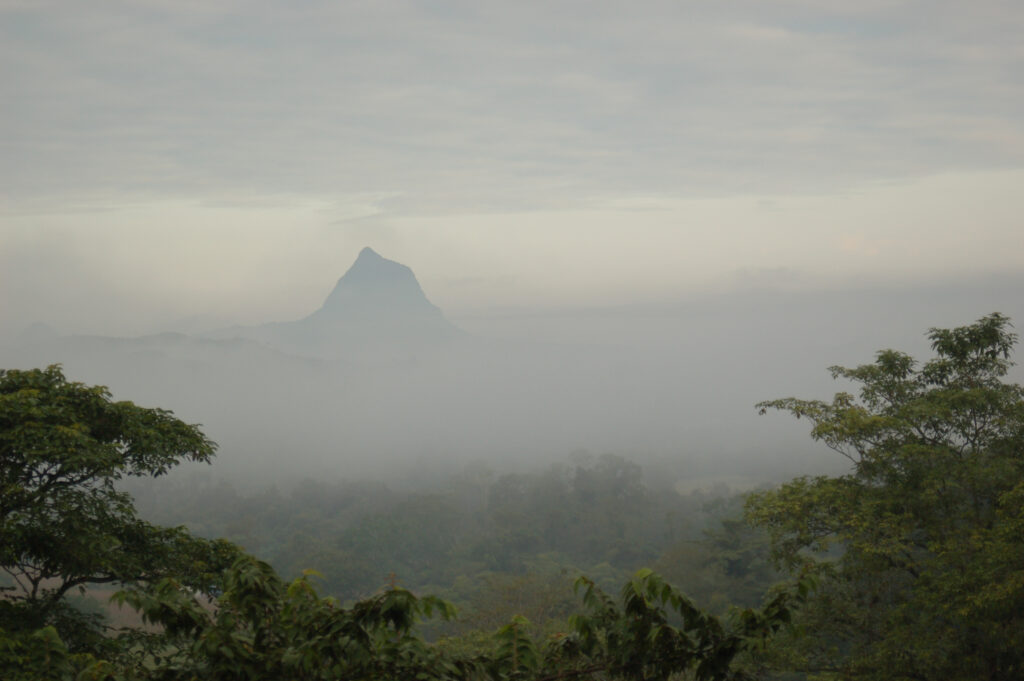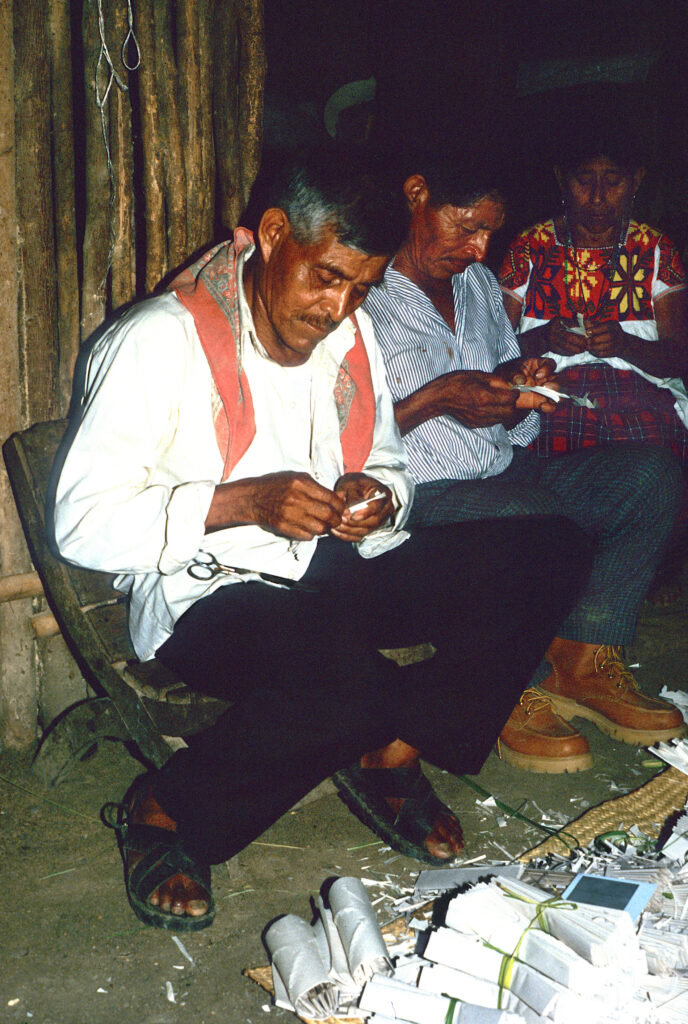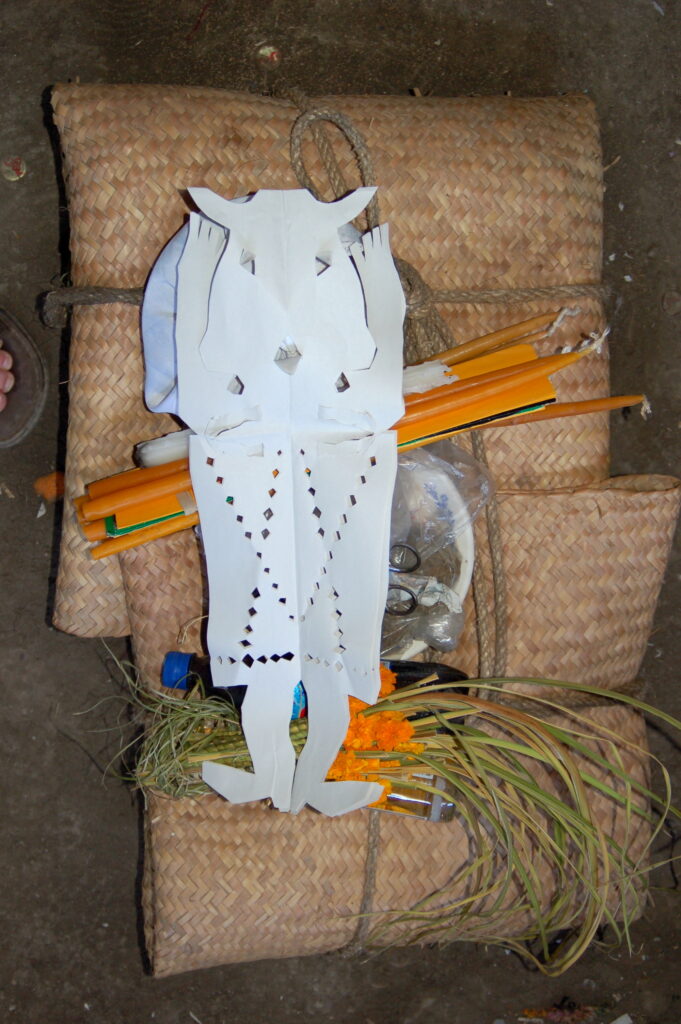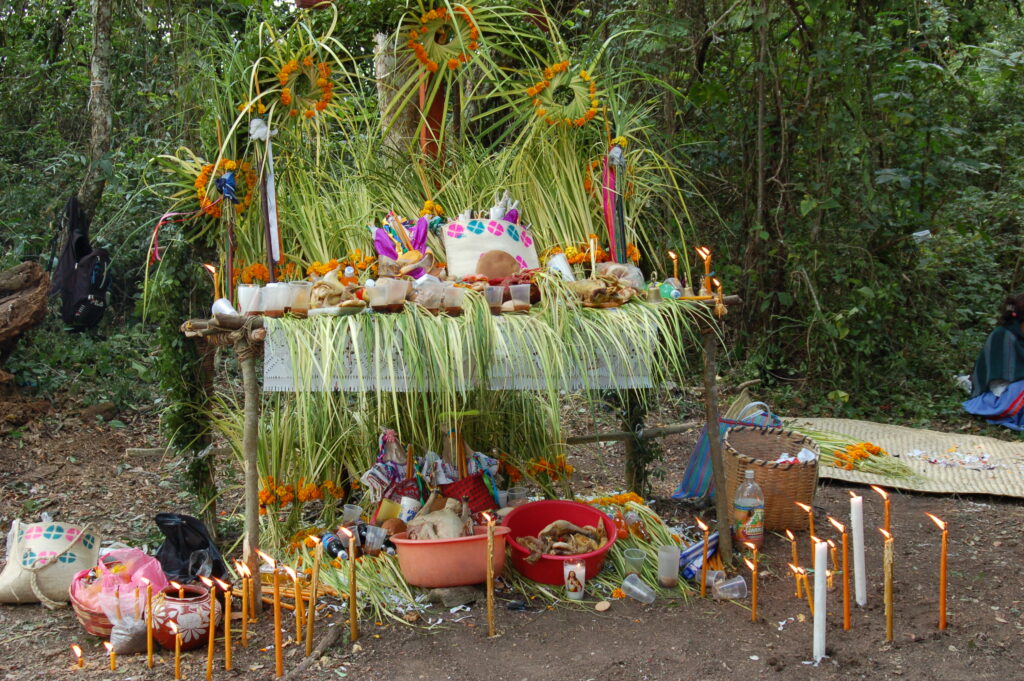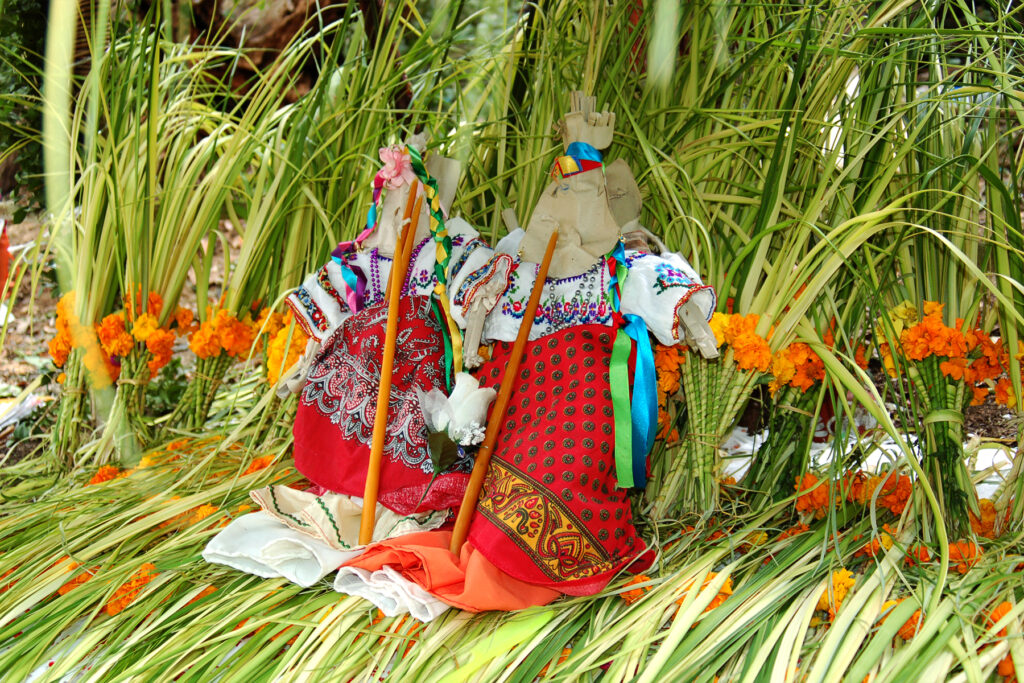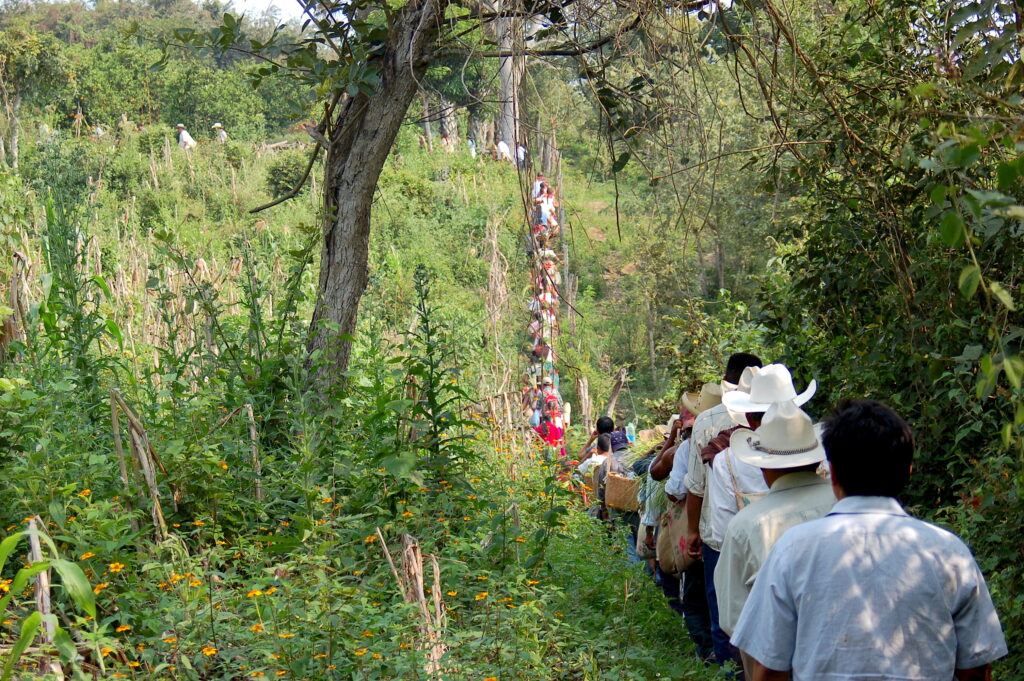Why Nahua Pilgrims Carry Thousands of Papers Up Sacred Peaks
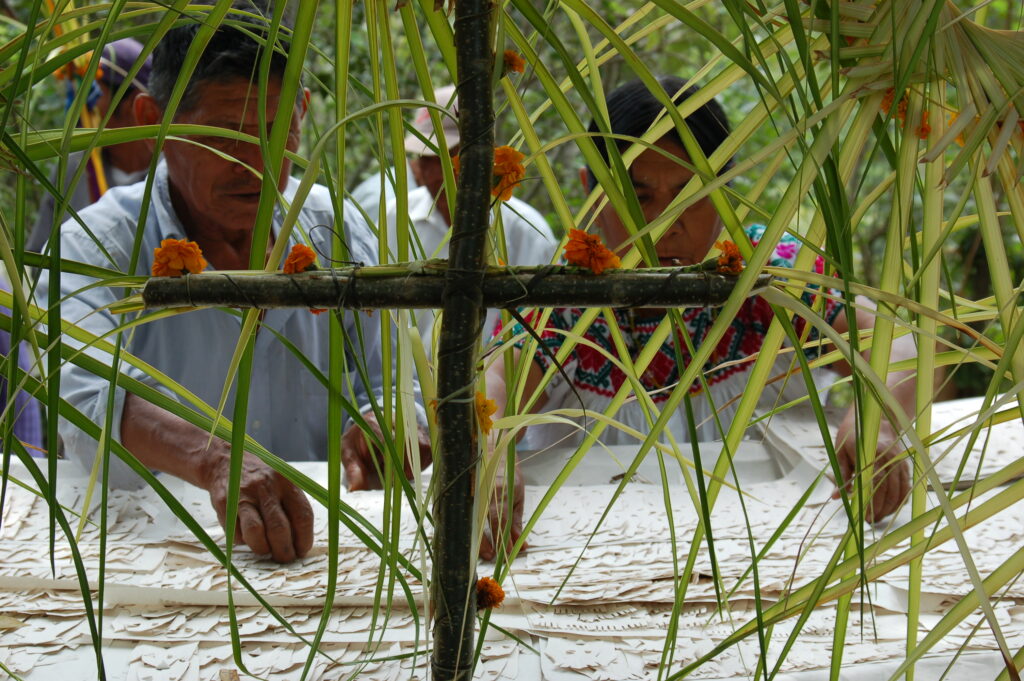
Based on Pilgrimage to Broken Mountain: Nahua Sacred Journeys in Mexico’s Huasteca Veracruzana by Alan Sandstrom and Pamela Effrein Sandstrom. University Press of Colorado, 2022.
In a small Nahua community, situated in the foothills of northern Veracruz, Mexico, preparations were underway for a major ritual event. After 28 years as students of this Indigenous group’s social life and customs, we were excited to participate in our first pilgrimage to Postectli, the most significant mountain in the Nahua sacred landscape.
People say Postectli once connected the terrestrial world with the celestial realm, but its summit was severed during cataclysmic events that ushered in the present age. The jutting peak of the 2,000-foot basaltic monolith certainly appears to have been broken off by some tremendous force.
A circle of busy ritual specialists folded sheets of paper and cut elaborate figures with scissors, piling their creations on decoratively cut paper beds. For a pilgrimage of this magnitude, the skilled paper cutters produced well over 10,000 of these miniature figures with their human-like forms. The participants then carefully wrapped the paper cuttings in a palm mat to carry on their pilgrim’s trail.
After that first Nahua pilgrimage we joined in 1998, we continued with renewed vigor our investigation of these paper cutouts, which feature so prominently in the ritual life of the village that we call “Amatlán” (“place of paper trees”) to protect people’s privacy.
Through our long-term ethnographic research, the paper cutouts helped us understand that Nahua religious philosophy fosters a unity between humanity and the natural world—and this perspective offers urgent lessons for people worldwide. Time may be running out for global citizens to heal the Earth and air that bestow life. A great deal can be learned from the Nahua about how to adjust attitudes and relationships to achieve balance with what Euro-Americans typically label as “nature.”
NAHUA PILGRIMAGE AND PAPERS
The Nahua of this region are primarily maize farmers who speak the Nahuatl language and are probably descendants of the Aztecs and Toltecs. Nahua people have settled throughout Mexico and Central America, and some now live in urban centers or abroad. Amatlán, the community we have joined for decades, is nestled below the Sierra Madre Oriental mountain range.
Like many members of other Nahua communities, residents of Amatlán are practitioners of the religion known as el costumbre. [1] [1] By using the article el instead of la, they make the meaning of the Spanish word for “the custom” their own. Undertaking pilgrimages to the summits of venerated mountains expresses religious devotion and commitment to their Indigenous identity.
The journeys involve long treks through rugged terrain, culminating in sometimes perilous climbs up steep tropical trails. Pilgrimages may be held on a yearly basis or during times of need. They vary in duration from a few hours to perhaps eight days or longer, depending on the destination.
Participants carry everything they need to construct elaborate altars along the trail and on the mountain. The altars are laden with copious offerings, and the paper figures are embodied by key spirit entities. The devotees—men and women, younger and older individuals—perform heartfelt chanting, play sacred music on guitar and violin, and dance before the altar. To the ephemeral images cut from paper, they offer precious items such as incense, tobacco, food, drink, and the blood of sacrificial fowl.
Early on, we decided to focus our research on the costumbre ritual paper-cutting practices because the figures seemed to be a ready-made inventory of the Nahua spirit world. Fearing the loss of their traditions from the invasive forces of missionaries and modernization, the ritual specialists willingly provided samples of their paper creations. They also shared knowledge of the entities’ names and relationships to one another, and encouraged us to document the rituals.
not MANY but ONE
To our eyes, countless different entities populated the Nahua spirit world. We were intrigued by how the Nahua practitioners innovated, expanding their repertoires almost infinitely with new paper cuttings.
We repeatedly inquired why so many different spirits were embodied in paper and how a Nahua ritual specialist (or tlamatiquetl, a person of knowledge, in the contemporary Huastecan Nahuatl dialect) can add to them seemingly at will. At some point, we got an answer from Encarnación Téllez Hernández, widely known beyond Amatlán by his nickname “Cirilo.”
The master tlamatiquetl gave us a quizzical look and replied bluntly, “They are all the same.”
Surrounded by hundreds of his exquisite paper cuttings, we dutifully took note and puzzled over the answer for a long time.
It is true that virtually all the figures are anthropomorphs: a human bodily form, with a head, arms, hands, legs, and feet. However, they are also distinguished by certain iconographic cuts. Each has a name and a rich set of associations in oral narratives. Surely, we thought, these multitudes of paper figures are separate beings.
In time, we came to realize that Cirilo had shown us precisely what we needed to grasp.
The Nahua spirit pantheon is filled with entities that appear to be linked to what many Euro-Americans conceive of as nature and the cosmos: notably water, clouds, seeds, sun, stars, the sacred Earth itself, and the dangerous winds associated with disease and misfortune.
But these spirits do not exist in a hierarchy; nor do they each maintain a discrete domain of control. Rather, every being and object in the cosmos is composed of identical sacred substance. The many spirits are but aspects or manifestations of this uniform singularity. That’s why the mutable Nahua spirits often lose their individual identities by merging or blending into one another, and people can readily incorporate novel entities such as Catholic saints to address new circumstances.
As Cirilo told us, “They are all the same.”
Still, we wondered why the paper cutouts of entities such as water and sun assumed human outlines.
With time, we learned: For the Nahua and neighboring groups in Mesoamerica, the template for understanding all reality—from microscopic to macro-scale phenomena—is the human body. People picture the Earth, celestial bodies, the maize plant, the cordillera of sacred mountains, and the invisible winds in bodily form.
For this reason, virtually all Nahua paper figures are anthropomorphs. The singular bodily form connects one cutting to the next, providing visual affirmation that despite the appearance of diversity, their underlying essence is anchored in one reality.
The cosmos itself is the deity: The creator and the creation are the same. In this form of pantheism, every being and thing are one—a part of the sacred cosmos.
DIVINITY’S NATURE
The Nahuas call their all-inclusive, animated cosmos Totiotzin, or “Our Honored Divinity,” and view human beings as fully part of it.
Because everything in the universe is an expression of the divine presence (often spoken of as “deity”), the Nahua do not have the dualistic concept of absolute good and evil that is fundamental, for example, to Judeo-Christian-Islamic traditions.
Things or processes that are normally salutary may turn lethal, while dangerous or threatening phenomena may prove beneficial. Under normal conditions, cosmic elements balance precariously; everything that people value—rain, fertility, healthy children, crop abundance—is forthcoming from the functioning universe. But when equilibrium inevitably goes off balance, disease, drought, famine, and all sorts of misery ensue. The overarching goal of Nahua religious practice is to achieve and maintain a reciprocal balance between human beings and what many Euro-Americans regard as the forces of nature.
Totiotzin is a power or energetic force that does not take a direct interest in human affairs, cannot be prayed to, and is indifferent to the fate of humans following death. It interacts with people through its many embodied aspects but otherwise remains aloof to humanity.
To us, Totiotzin is very much like the ecosystem in which human beings live—we owe our lives to it, yet it has no stake in humanity’s existence. It is all around us, and people may be aware of it in total, yet its workings lie largely beyond human consciousness.
A NAHUA PILGRIMAGE OF RESPECT
Back in 1998, the trail twisted and turned, but the stalwart pilgrims carried on for the benefit of all. By taking the journey and dedicating offerings to the paper cutouts on the mountain, the community demonstrated its respect and willingness to engage in reciprocity with the environmental forces that sustain them.
The mountains, sun, rain, Earth, and seeds are sacred for the Nahua because they exist; they exist because they are sacred. They constitute Totiotzin, and they demand one thing—that people show respect. From the Nahua perspective, anyone who cannot see that simple fact has slipped off the pilgrim’s trail, lured into the illusion that human beings are independent of the fundamental forces that structure and energize the cosmos.
The Nahua worldview can help those accustomed to living amid forms of material wealth in economies that are based on resource exploitation. It can teach people how to see new possibilities, adjust their priorities, and think more realistically about the costs of continuing to follow old patterns.
Following the Nahua example, the rest of us might undertake sacred journeys to cultivate respect and recognize the dignity of the beings and things that constitute the cosmos.
































